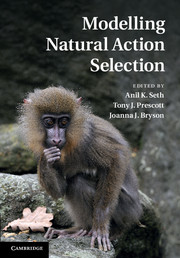Book contents
- Frontmatter
- Contents
- Foreword
- Preface
- Contributors
- 1 General introduction
- Part I Rational and optimal decision making
- Part II Computational neuroscience models
- 9 Introduction to Part II: computational neuroscience models
- 10 Action selection and refinement in subcortical loops through basal ganglia and cerebellum
- 11 Cortical mechanisms of action selection: the affordance competition hypothesis
- 12 Toward an executive without a homunculus: computational models of the prefrontal cortex/basal ganglia system
- 13 Hierarchically organised behaviour and its neural foundations: a reinforcement-learning perspective
- 14 The medial reticular formation: a brainstem substrate for simple action selection?
- 15 Understanding decision-making deficits in neurological conditions: insights from models of natural action selection
- 16 Biologically constrained action selection improves cognitive control in a model of the Stroop task
- 17 Mechanisms of choice in the primate brain: a quick look at positive feedback
- Part III Action selection in social contexts
- Index
- Plate section
- References
15 - Understanding decision-making deficits in neurological conditions: insights from models of natural action selection
from Part II - Computational neuroscience models
Published online by Cambridge University Press: 05 November 2011
- Frontmatter
- Contents
- Foreword
- Preface
- Contributors
- 1 General introduction
- Part I Rational and optimal decision making
- Part II Computational neuroscience models
- 9 Introduction to Part II: computational neuroscience models
- 10 Action selection and refinement in subcortical loops through basal ganglia and cerebellum
- 11 Cortical mechanisms of action selection: the affordance competition hypothesis
- 12 Toward an executive without a homunculus: computational models of the prefrontal cortex/basal ganglia system
- 13 Hierarchically organised behaviour and its neural foundations: a reinforcement-learning perspective
- 14 The medial reticular formation: a brainstem substrate for simple action selection?
- 15 Understanding decision-making deficits in neurological conditions: insights from models of natural action selection
- 16 Biologically constrained action selection improves cognitive control in a model of the Stroop task
- 17 Mechanisms of choice in the primate brain: a quick look at positive feedback
- Part III Action selection in social contexts
- Index
- Plate section
- References
Summary
Summary
Models of natural action selection implicate fronto-striatal circuits in both motor and cognitive ‘actions’. Dysfunction of these circuits leads to decision-making deficits in various populations. We review how computational models provide insights into the mechanistic basis for these deficits in Parkinson's patients and individuals with ventromedial frontal damage. We then consider implications of the models for understanding behaviour and cognition in attention deficit/hyperactivity disorder (ADHD). Incorporation of cortical norepinephrine function into the model improves action selection in noisy environments and accounts for response variability in ADHD. We close with more general clinical implications.
Introduction
Fronto-striatal dysfunction can lead to dramatic changes in cognition and action, as evidenced by various disorders with disturbances to this circuitry, including Parkinson's disease (PD), schizophrenia, attention deficit/hyperactivity disorder (ADHD), obsessive–compulsive disorder, Tourrette's syndrome, Huntington's disease and addiction (Nieoullon 2002). One might wonder how adaptive evolution of a brain system could lead to the complexity and diversity of behaviours associated with these disorders, especially since these behaviours generally do not occur spontaneously in animals. However, we could also turn this question on its ear and ask: how elegant must a neural system be to lead to more rational human behaviour? It may be an unfortunate but necessary corollary that the complexity required to produce adaptive thought and behaviour may be vulnerable to all manner of issues with the ‘plumbing’, which would have compounding effects on the overall system. Thus the trade-offs that come with adaptive human behaviour may be akin to those associated with a car that has electronic seat position control and GPS navigation – these luxurious amenities come with increased risk of something breaking in an unpredictable fashion.
- Type
- Chapter
- Information
- Modelling Natural Action Selection , pp. 330 - 362Publisher: Cambridge University PressPrint publication year: 2011
References
- 2
- Cited by



